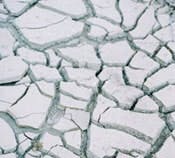Once fertile lands are turning into arid deserts at an alarming rate, the United Nations said.
As land masses the size of Rhode Island turn to dust each year, residents of these areas flee to cities and more fertile areas to survive.
This week the United Nations marks the 10th anniversary of the Convention to Combat Desertification, a plan aimed at stopping the phenomenon.
"It's a creeping catastrophe," said Michel Smitall, a spokesman for the U.N. secretariat that oversees the 1994 accord. "Entire parts of the world might become uninhabitable."
And he's not exaggerating. Since the 1950s, China has lost 36,000 square miles to desert, an area the size of Indiana. Furthermore, 31% of Spain is threatened, as are large swaths of Africa as well as many other areas around the world. In all, one third of the world's land may be at risk.
The reasons? Slash-and-burn agriculture, sloppy conservation, overtaxed water supplies and soaring populations are mostly to blame. But global warming is taking its toll, too.
The United Nations is holding a ceremony in Bonn, Germany, on Thursday to mark World Day to Combat Desertification, and will hold a meeting in Brazil this month to take stock of the problem, the Associated Press reported.
As populations expand, typically dry regions have become increasingly stressed. Trees are cut for firewood, grasslands are overgrazed, fields are over-farmed and lose their nutrients, and water becomes scarcer and dirtier. Eventually, the regions simply dry up.
Technology can make the problem worse, the Associated Press reported.
• In parts of Australia, irrigation systems are pumping up salty water and slowly poisoning farms.
• In Saudi Arabia, herdsmen can use water trucks instead of taking their animals from oasis to oasis – but by staying in one place, the herds are getting bigger and eating all the grass.
• In Spain, Portugal, Italy and Greece, coastal resorts are swallowing up water that once moistened the wilderness.
The result is a patchy "rash" of dead areas, rather than an easy-to-see expansion of existing deserts, scientists say. These areas have their good times and bad times as the weather changes. But in general, they are getting bigger and worse-off.
"It's not as dramatic as a flood or a big disaster like an earthquake," said Richard Thomas of the International Center for Agricultural Research in the Dry Areas in Aleppo, Syria. "There are some bright spots and hot spots. But overall, there is a trend toward increasing degradation."
As for the American Southwest, it is too early to tell whether its six-year drought could turn to something more permanent. But scientists note that reservoir levels are dropping as cities like Phoenix and Las Vegas expand.
The Global Change Research Program says global warming could eventually make the Southwest wetter – but it will also cause more extreme weather, meaning harsher droughts that could kill vegetation, the Associated Press reported. Now, the Southwest drought has become so severe that even the sagebrush is dying.
"The lack of water and the overuse of water, that is going to be a threat to the United States," Thomas said. "In other parts of the world, the problem is poverty that causes people to overuse the land. Most of these ecological systems have tipping points, and once you go past them, things go downhill."
Source: Associated Press


